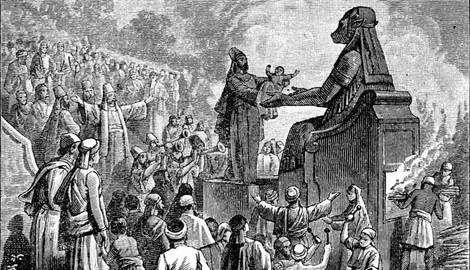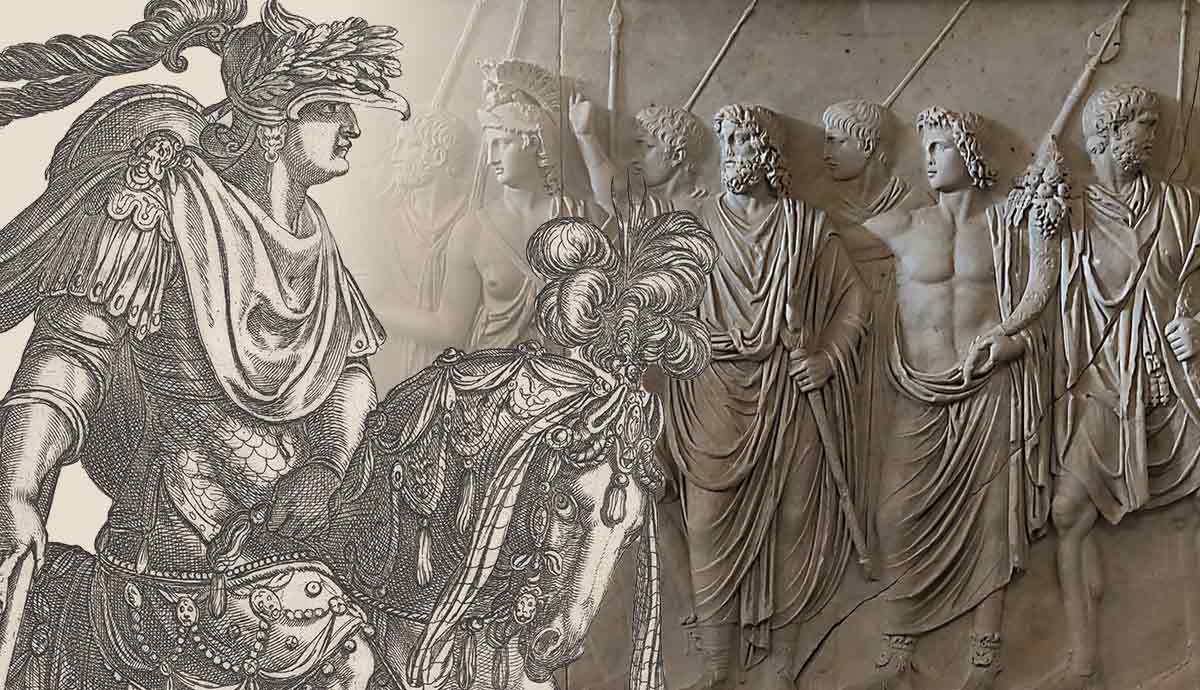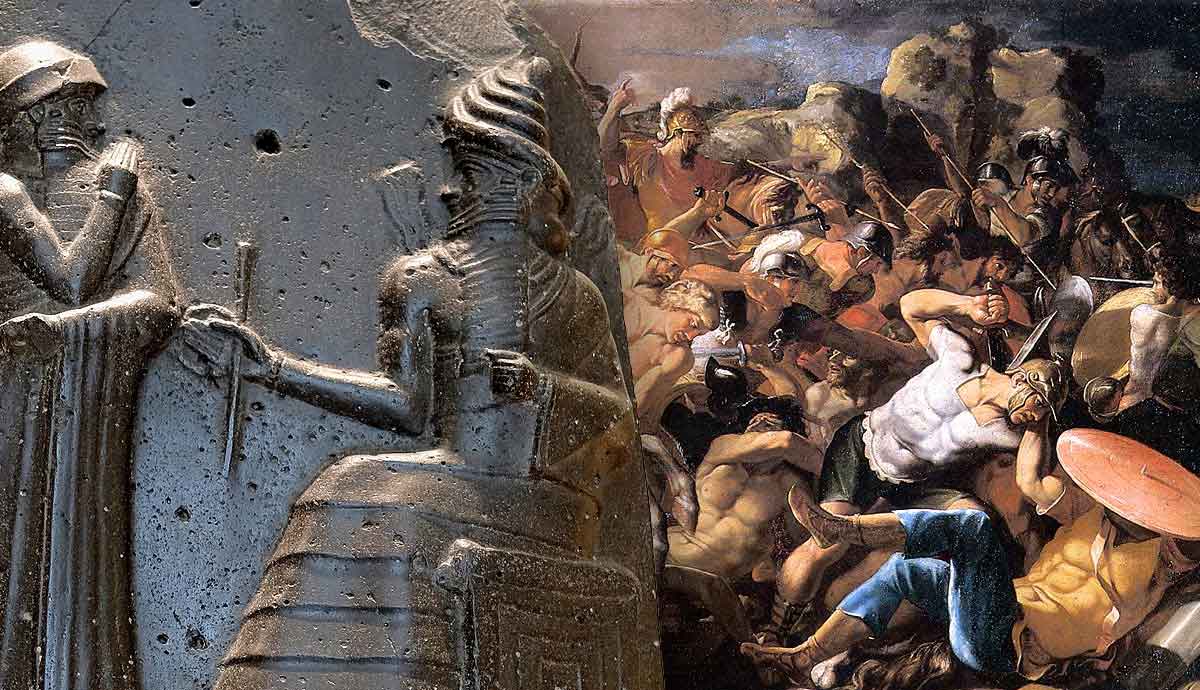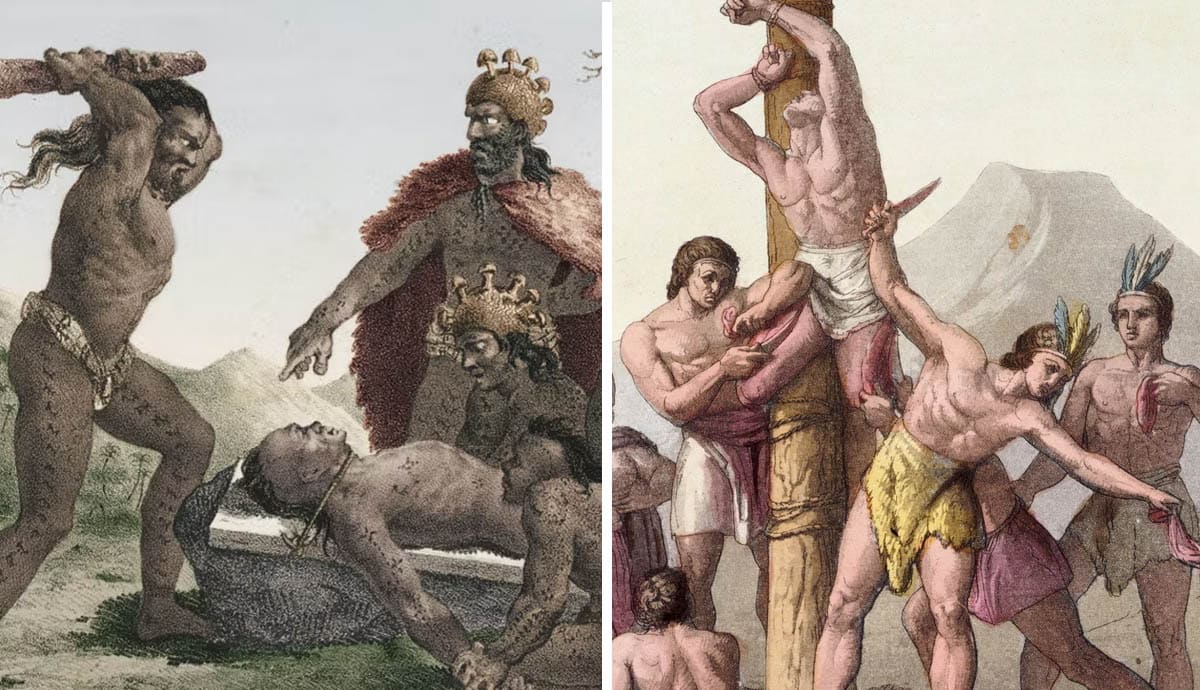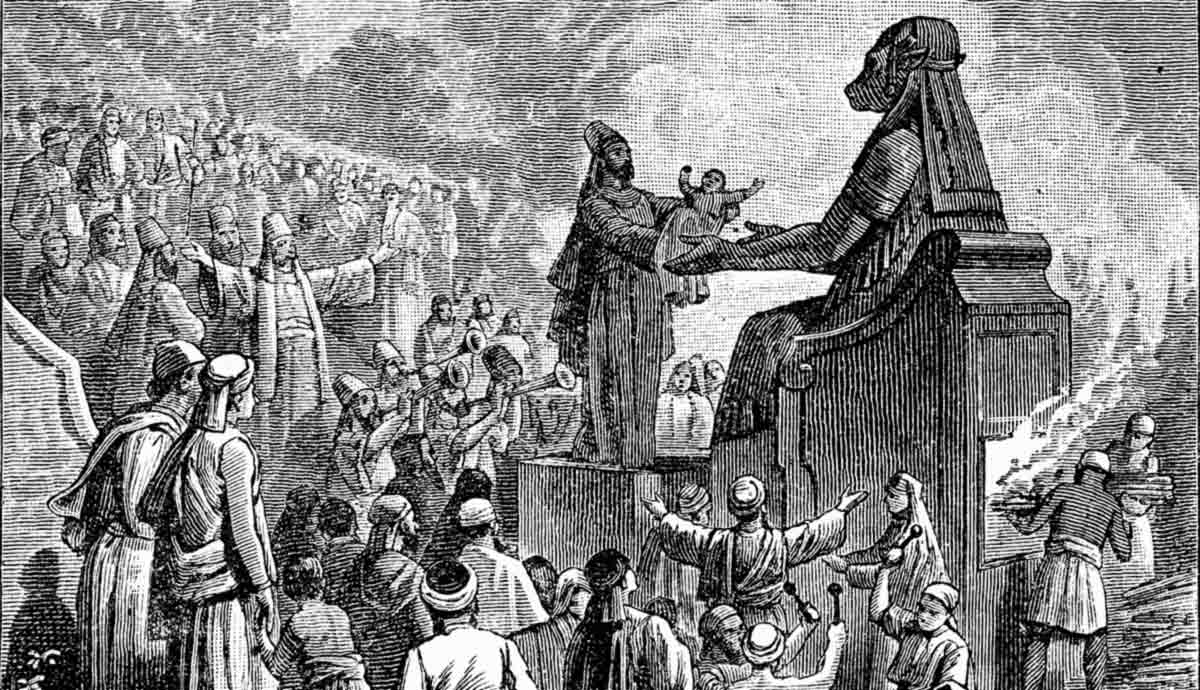
The Bible associates Moloch (Molech) worship, a practice common to Canaanite and Phoenician nations, with child sacrifice. The word “Canaanite” refers to a collection of independent city-states in the Levant region (modern-day Palestine, Syria, Israel, Jordan, and Lebanon) who shared linguistic and cultural traits but had distinct identities between 3000 and 1000 BCE. The Phoenicians were direct descendants of the Canaanites who resided in coastal cities of the Levant between 1500 and 300 BCE. They settled a colony in Carthage that later became a prominent Roman city. Moloch worship was common among these cultures and others in the Mediterranean, as archaeological evidence indicates.
Moloch Worship

Moloch (מֹלֶךְ) (also Molech, or Molek) has the same Hebrew root as melek (מֶלֶךְ) which means “king.” There is a scholarly debate as to whether Moloch is the proper name of the god or a title related to child sacrifice. One reason is that the definite article that precedes the MLK suggests a title rather than a name. Some scholars have suggested that Moloch is a mislocalization of Melek using the vowels of bosheth (shame), though this view has weak foundations. Other scholars believe the word Moloch refers to the sacrifice itself because that is what the word means in Punic, the language spoken in Carthage and related to the word Phoenician.
In the Bible, Moloch’s worship is most closely associated with the Ammonites, who were Canaanites (1 Kings 11:7). More general references to the Canaanites sacrificing children show that the practice was not limited to the Ammonites. Because of their shared cultural heritage, it is more than likely that other Canaanite groups, such as the Amorites, Girgashites, Hittites, Hivites, Jebusites, Perizzites, and Sidonians, also worshiped Moloch.
Before the Israelites entered Canaan to conquer it, God issued them with the following warning:
“When the LORD your God cuts off before you the nations whom you go in to dispossess, and you dispossess them and dwell in their land, take care that you be not ensnared to follow them after they have been destroyed before you, and that you do not inquire about their gods, saying, ‘How did these nations serve their gods?—that I also may do the same.’ You shall not worship the LORD your God in that way, for every abominable thing that the LORD hates they have done for their gods, for they even burn their sons and their daughters in the fire to their gods.” (Deuteronomy 12:29-31).
Moloch Worship Among the Israelites

The Israelites did not annihilate the nations that occupied Canaan, their Promised Land when they took it into their possession. Later, some of their kings were guilty of allowing and practicing Moloch worship. Among them were Solomon (1 Kings 11:7), Ahaz (2 Kings 16:3), and Manasseh (2 Kings 21:6). Solomon had high places, called bamah in Hebrew, built for the worship of Chemosh and Moloch on a mountain east of Jerusalem. Ahaz and Manasseh burned their own sons as sacrifices, following the practices of the Canaanites. Psalm 106:34-41 relates the disobedience of God’s people on this matter and claims it was one of the reasons for their exile.
God explicitly mentioned this sin in Jeremiah 7:30-31:
“For the sons of Judah have done evil in my sight, declares the LORD. They have set their detestable things in the house that is called by my name, to defile it. And they have built the high places of Topheth, which is in the Valley of the Son of Hinnom, to burn their sons and their daughters in the fire, which I did not command, nor did it come into my mind.”

Ezekiel, who prophesied in the early 6th century BCE, also referred to the abomination of child sacrifice in the kingdom of Judah. Ezekiel 16:20-21:
“And you took your sons and your daughters, whom you had borne to me, and these you sacrificed to them to be devoured. Were your whorings so small a matter that you slaughtered my children and delivered them up as an offering by fire to them?”
Moloch worship was pervasive because the Israelites did not drive the heathen nations from the promised land. Because they were allowed to remain, the Israelites learned the abominable practices from them. King Josiah destroyed the Topheth in the Valley of Hinnom to prevent it from being used to sacrifice children again (2 Kings 23:10), but the references by Ezekiel and Jeremiah show that it continued afterward.
Topheths

The reference to Jeremiah considered above, mentions “the high places of Topheth.” Topheth is the name for a place where worshipers of Moloch performed child sacrifices. The Topheth in the Valley of Hinnom was likely the place of worship established when Solomon constructed the high place to Moloch for his wives.
The Greek word gehenna, which comes from the Hebrew gei ben-Hinnom, originally referred to the Valley of Hinnom. Because of the abomination of child sacrifices in the Valley of Hinnom, the word Gehenna aligns with burning, human suffering, torture, and evil. By the Second Temple period (c. 500 BCE-70 CE), Gehenna no longer referred to a physical location of burning but became a symbol of divine wrath, destruction, and the afterlife punishment of the wicked.
During the early 1900s, Robert Alexander Stewart Macalister, an archaeologist who conducted excavations in Gezer, discovered ten stones that were aligned and dug deeper to uncover the significance of the stones. The stones had a basin at the bottom. Around the complex, he found ten jars with the bones of girls of very young age in them, one possibly being a mere couple of days old. The bones showed evidence of burning, and some corpses were cut in two while others were decapitated.
A direct connection between Moloch and this Topheth was not established, but some scholars hypothesize that Moloch is an epithet for Baal, which may explain the mention of Baal in connection with Manasseh’s sacrifice of his son (2 Kings 21:3-6).
The associated altars and stone pillars were typical of Canaanite worship sites and provided a link connecting the practices of child sacrifice in Canaan with similar sites and practices in Carthage.
Moloch Worship Outside of the Levant

In the Carthaginian context, inscriptions referring to places where the remains of children sacrificed to gods were buried, never use the term Topheth but rather the word for house or shrine. Unfortunately, no ancient Carthaginian record of what these sacrifices entailed in North African culture has been found. It is up to archaeologists to decipher the remains they discover and attempt to deduce what the ritual practices were.
Cleitarchus, a Greek historian, provides a vivid yet grotesque description of the sacrifice of children by the Carthaginians. He wrote:
“Phoenicians, and above all Carthaginians, worship Kronos; if they wish to achieve something big, they devote a child of theirs, and in the case of success, sacrifice it to the god. There is a bronze statue of Kronos among them, which stands upright with open arms and palms of its hands facing upwards above a bronze brazier on which the child is burnt. When the flames reach the body, the victim’s limbs stiffen and the tense mouth almost seems like it is laughing until, with a final spasm, the child falls in the brazier.”
Kronos seems to have been the Greek equivalent of Moloch or Baal-Hammon in the Phoenician tradition. The Greeks would call foreign gods by the name of their gods who most closely resembled them in mythological roles and worship practices. According to Greek mythology, Kronos devoured his own children.
In North Africa, the remains of the infants found in urns at these places of sacrifice were often intermingled with that of animals, mostly lambs. It suggests that the infants were sacrificed alongside the animals. Archaeologists have discovered similar topheths in various places in the Mediterranean, such as Malta, Sicily, and Sardinia.

In contemporary culture, artists often depict Moloch as a bull with outstretched arms, ready to receive the child sacrifice. Archaeological evidence supporting such a depiction is lacking, and the depiction seems like a later invention. Descriptions by Diodorus Siculus (1st century BCE, Bibliotheca Historica 20.14) and Cleitarchus (quoted by later authors like Porphyry, 3rd century CE) depict the bronze idol posed with outstretched arms over a fire pit or brazier. Artists often depict Baal with the head of a bull. The Israelites had a propensity toward creating idols in the image of calves, which may have originated from idols they had seen among the heathen nations (Exodus 32, 1 Kings 12:28).
Considering what we know of Moloch, it is reasonable to conclude that it is an epithet for Baal and that Kronos is the name of the equivalent in Greek culture. It would explain the connections in Plutarch’s statement in De Superstitione:
“A Carthaginian statue of Kronos stood with hands stretched out to receive infants who rolled into the fire beneath.”
